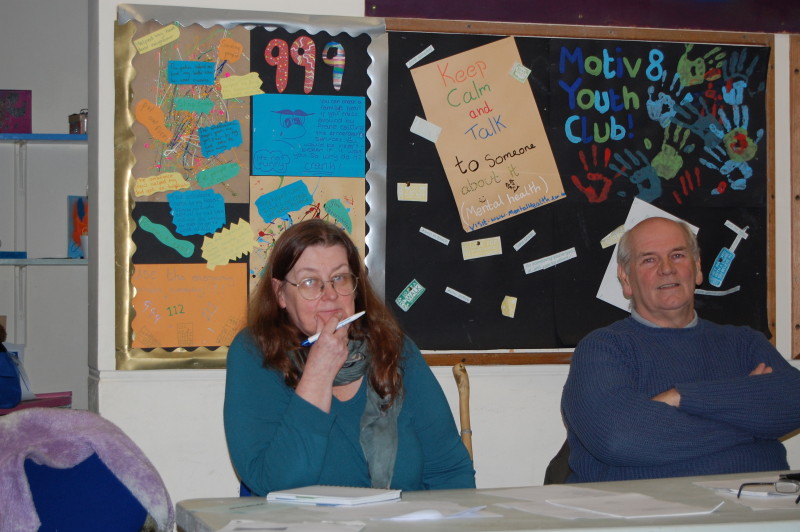There were few surprises or answers – but a lot of questions – at the Rye Partnership AGM in the Tilling Green Community Centre last Thursday March 17. But it was announced that new plans are being submitted to develop the site.
Apologies for absence from director Ian Ross again this year left the meeting with unanswered questions on the accounts – which apparently were not properly audited.
The Rye Partnership, set up in 1996, aims to bring together key stakeholders to develop a local community response to the socio-economic problems prevalent in the area.
But the status of its website also drew fire, there having been little action to address the recommendation in the National Audit Office Report of March 2009, that communication with residents be improved through the use of a website.
Councillor Keith Glazier from the chair (who is also leader of East Sussex County Council [ESCC]) stated that there was no one on the Partnership staff with the necessary IT experience and welcomed an offer of help from Anthony Kimber to remedy this.
The future development of the Tilling Green Community Centre site (occupied by old school buildings and owned by ESCC) is still far from clear though, the meeting there was told.
Housing association Amicus Horizon’s consultations with the Environment Agency about flood levels and drainage were ongoing (after objections were raised to a planning application made before Christmas), and the legal position was still at the “Heads of Terms” stage with no exchange of binding contracts between ESCC and Amicus.
It was still possible for Amicus to withdraw if design obstacles proved too expensive. Members were informed that new plans would be submitted shortly, and that more information should become available in four weeks’ time.
As regards the mooted relocation of the Partnership offices from Tilling Green (as they currently run the centre) , Cllr Glazier commented that “we will not walk away and let this place fail – we are committed to making this work as a community centre”.
He reported that Chapman’s of Sevenoaks, the new lessees of the fish processing plant at Rock Channel (another area of Partnership activity) , had stripped out, cleansed and re-clad the interior of the premises, but had still not taken active occupancy. They were expected to start in Rye in the next few months.
The Partnership is now seeking to develop the rest of its land-holding at Rock Channel. A previous consultant’s report commissioned by Rye Partnership and Seaspace, another quango (quasi autonomous non-governmental body) from Hastings, had named this area as the “Rye Peninsula”.
Rother District Council (RDC) had then produced a fully detailed Special Planning Document (SPD) based on this report that was meant to be included in the local Rye Neighbourhood Plan – but it was subsequently abandoned. The total cost of all this work is not known, but a low estimate would be in excess of £50,000.
This SPD has been quietly filed away as being too grandiose and impractical, and a new consultancy team appointed, headed by Paul Thurston and Martin Jones, a former Rye Partnership director, who has just stood down.
Their remit is to develop a realistic and deliverable business plan “starting with a blank sheet of paper” said Cllr Glazier. Funding grants, to be applied for, would offset the additional consultancy costs, which could amount to another £25,000.
John Howlett took the opportunity to ask whether the Partnership could influence the University of Brighton’s review and possible decision to close its Hastings campus. The Chairman expressed the hope that the University would not pull out, but said that this was a matter for them and for ESCC.
Planned for 2,000 students, the courses had never attracted more than half that number, and the student roll was now around 600. He understood that the 2015 courses would continue to completion.
The Partnership had achieved delivery of its employability project and completed learning outcomes. The directors were pleased, said the chairman, that the annual accounts, for the year ended March 31 2015, showed only a very small loss as compared to that of the previous two years.
It was then that Christopher Strangeways intervened: “There is absolutely no detail provided concerning turnover of £237,908, or cost of sales at £173,628 – what is this expenditure?” he demanded, continuing: “the Partnership is using public funds and should be publicly accountable”.
Despite this criticism, members formally approved the accounts by a majority of 10 – 1 on the assurance from the chair that the accounts had been duly audited.
In actual fact, the accounts carried a strong disclaimer in the Auditors’ Report to the effect that “we have not been instructed to carry out an audit or review of the financial statements of Rye Partnership. For this reason, we have not verified the accuracy or completeness of the accounting records …”.
Christopher Strangeways went on to question the need for the Partnership’s existence and proposed that its activities and assets should be taken over by Rye Town Council, a democratically elected body.
Peter Turner pointed out that the Rye Harbour Stores, one of the Rye Partnership’s assets, is not in Rye. The chairman observed that the Town Council had shown no inclination to become involved – it being noted that only one Rye Town Councillor was present at the meeting.
The chairman undertook that the finance officer would make himself available for providing any further explanation regarding the accounts.
Two new directors were appointed, both with strong local connections – Peter Turner, chairman of Icklesham Parish Council (which covers Rye Harbour) and Tony Hills, fisherman and former governor of Rye College.
The chairman welcomed them and thanked his colleagues, paying special tribute to Sam Souster, a former RDC and Town Councillor, who had served on the board for many years and retired last May 2015. Continuing directors are: Keith Glazier (chairman), Jo Kirkham (a Town Councillor) , Dan Shelley, Gina Sanderson and Ian Ross.
Photo: Kenneth Bird



